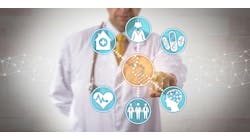PatientKeeper
Over the last eight years, the healthcare industry has seen a dramatic increase in information technology adoption by clinicians. Nearly 96% of hospitals now are using a certified electronic health record (EHR) system, according to ONC data, which is a nine fold increase since the Health Information Technology for Economic and Clinical Health (HITECH) Act became law in 2009.
But while healthcare provider organizations generally have gone digital, many clinicians are still left wondering whether information technology has improved efficiency, streamlined care delivery, or improved patient outcomes. Take EHRs, for example. Many clinicians believe these systems have actually made them less productive and hindered patient care and interactions. In fact, a recent Brown University study found that physicians liken the effect of EHR usage on patient interactions to someone texting at the dinner table—a distracting, disruptive behavior owing to an intrusive technology.
However, despite all the well-publicized problems of EHRs, clinicians have seen benefits from technology, too. Not long ago specialists had to spend the night in the hospital just in case their expertise was needed. Then came pagers, and they were able to come to the hospital only as and when needed. Fast-forward to today: Technology allows clinicians to completely review up-to-the-second information about a patient and properly triage that patient remotely from their mobile device, making better, highly specialized care more widely available, and saving lives in the process.
So, what can clinicians expect the future of digitally enabled healthcare to look like? Here are a few examples of the transformation that is already in progress:
- Clinical decision-making tools are helping clinicians by presenting the most important information at the point of care. For instance, applied artificial intelligence (AI) is putting the power of “machine learning” at the forefront of next-generation care. Think of Amazon’s “suggestions” when a consumer makes a purchase online; through data analytics and IT, the site automatically makes recommendations on what additional items they think that person may be interested in purchasing. The same concept can be applied to clinicians’ orders—AI can suggest which orders should be considered based on an analysis of treatment patterns in similar patients. At a minimum, this will save clinicians time by putting orders a click away. In some cases, this will help avoid a missed or delayed order that could affect patient safety.
- Adaptable user interfaces have the capacity to transform the way that doctors work by changing the way clinical data is presented based on a range of factors: The doctor’s specialty, personal care preferences, and the overall patient health situation. With paper-based health records, there was only one view, and no way for a specialist to highlight the most important information pertaining to the patient. With adaptable electronic interfaces to a computerized patient record, doctors are able to save time and reduce the chance of missing a critical piece of information.
- Clinical insights driven by “big data” analytics are also contributing to more efficient, actionable, and effective healthcare. One of the first targets for this type of effort is sepsis in the hospital environment. According to the National Institute for General Medical Sciences, sepsis accounts for more U.S. deaths than prostate cancer, breast cancer, and AIDS combined. One of the biggest reasons for this high mortality rate is the rapid progression of the illness, which requires quick detection and intervention. With a digitized health record and the constant vigilance of an inference engine, patients at risk for sepsis can be identified more quickly, when the disease is in its earliest stages, vastly increasing the number of lives that can be saved.
These are just a few examples of how information technology could transform care delivery. To realize the full potential of healthcare digitization, it will take more than just good technology. It must be incorporated seamlessly into the clinician workflow in a way that contributes to (rather than hinders) patient care.
Ultimately, we need to improve EHRs and related technology to the point that clinicians see it as integral and indispensable to patient care as the stethoscope. If we can continue to help clinicians optimize how they use technology, there is a huge opportunity to improve care quality and efficiency across the entire healthcare continuum. Then, and only then, will we start to see the full value of healthcare’s digital transformation.



